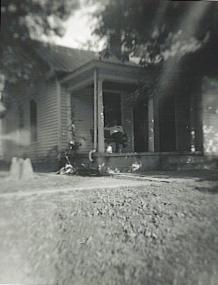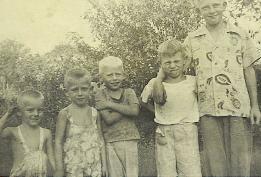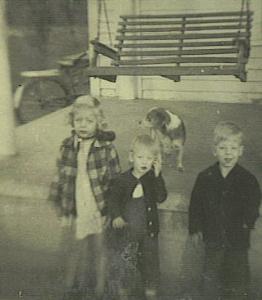Most of us were born in our house in New Haven, the idea of childbirth in hospitals still being a modernity in those days. The house had two bedrooms, one much sought after bathroom, (indoors I might add), a dining room, a living room and a kitchen. Don’t ask me how eight of us kids and Mama and Daddy all fit into those two bedrooms; I remember only that there were bunk beds and double beds shared.
The kitchen had a gas range and a small coal stove used to operate the homemade water heater. Meals were eaten at a table which was flanked by several chairs on one side and a backless bench on the other.
The house itself was heated by several coal stoves. Bringing in coal from the coal shed in buckets was one of our chores and also removing the ashes every day. The stove in the boys’ bedroom would get so hot in winter that it fairly glowed red and I marvel that no one got seriously burned or that the house itself did not burn down from it.
The funny thing is that none of us complained about the shortage of space proving that a lot of human dissatisfaction has to do with disappointed expectations more than anything else. Our house was across the street from the popcorn factory
 and next to the railroad station. Also across the street was the Baptist Church were you could hear strains of “Rock of Ages” on summer evenings when services were held with the windows open. The street in front of the house was gravel although the main streets of New Haven were paved and did have sidewalks.
and next to the railroad station. Also across the street was the Baptist Church were you could hear strains of “Rock of Ages” on summer evenings when services were held with the windows open. The street in front of the house was gravel although the main streets of New Haven were paved and did have sidewalks.
In the back yard was a cherry tree and an apple tree both of which were loaded with fruit every year. Next door were the Mattinglys who raised a hog every year in a penned off section of their backyard. New Haven boasted a population of 550 in the fifties. There was a town marshal who also ran the water system. One Methodist Church, one Baptist Church and a large Catholic parish provided places for people to be on Sundays.
The Big Store was a grocery store located on Center Street just a few doors east of Main Street
and up the street was Head’s store on the corner. I always heard that there was a patched hole in one of the walls of Head’s Store from a Civil War cannonball. I never put much stock in that until years later I learned that indeed, there had been some significant action in New Haven during the Civil War as it was located on a major north-south route for movement of armies through central Kentucky.
My mother used to say, when preparing a meal for our sizable family, “We’ve got enough food here to feed Bragg’s army!” That expression was over my head until I read only a few years ago that confederate General Braxton Bragg led his army of 28,000 through New Haven on the way to Bardstown in late September 1862. As it would have taken an entire day to march through town, it must have impressed the lady folk watching it. That phrase probably was coined to express huge crowds unseen before, and was passed on to succeeding generations in New Haven.
The first truly modern “super market” in New Haven was established by H. A. Dickerson, Hugh
Louis’ future father in law. It was located across the tracks from the Sherwood Inn.
Like many small towns, New Haven was bypassed by the interstate system but has continued as
a fine community and home for many great people.


